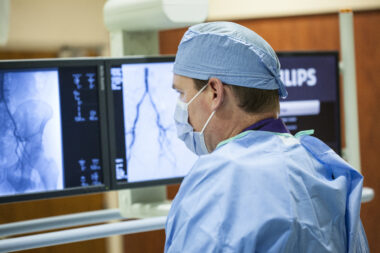Cramping, pain and discomfort are common for many women during their periods, but severe pain, heavy bleeding and irregular menstrual cycles can be signs of something more serious. Uterine fibroids, endometriosis and polycystic ovary syndrome (PCOS) are chronic conditions that affect many women during and after their childbearing years. Around 20% to 80% develop uterine fibroids, 11% of women in the U.S. have endometriosis, and 6% to 12% have PCOS. Some women may have more than one condition, making diagnosis even trickier.
If you have one of these painful conditions, you don’t have to suffer in silence. Early diagnosis and treatment of endometriosis, PCOS and uterine fibroids can alleviate symptoms you might not even know are caused by these conditions. Additionally, PCOS is linked to serious health conditions, such as diabetes and heart disease, and early diagnosis allows you to take steps to maintain your health and manage risk over time.
PCOS, Endometriosis and Uterine Fibroids, Explained
Due to sharing similar risk factors, PCOS, endometriosis and uterine fibroids are often confused with one another.
However, there are subtle differences in how they impact women’s bodies:
- Uterine fibroids are benign tumors that grow inside or outside your uterus. Their growth is affected by a few factors, including levels of estrogen and progesterone in your body and your genetics. They range in size from as small as a seed to as large as a softball and can cause symptoms including pain, cramping and heavy bleeding during menses.
- Endometriosis is a condition in which tissue similar to endometrial tissue — the lining of your uterus — grows in other parts of your body. Although endometriosis has many potential causes, a common cause is called retrograde menstruation, when some of this tissue sloughs off during your period and backs up into your fallopian tubes, then to your pelvis.
- PCOS is a hormonal imbalance that causes irregular periods and ovarian cysts. Women with PCOS have high levels of androgen, a male hormone, and they also have high levels of insulin. Women with PCOS are at increased risk for Type 2 diabetes, heart disease, high blood pressure, and high cholesterol, and they often need to follow special dietary and treatment plans to help manage the risk of developing these conditions over time.
Could I Have Uterine Fibroids, Endometriosis or PCOS?
All three conditions can cause mild to severe symptoms. Many women may not notice symptoms or attribute their symptoms to something else. While they are different conditions, endometriosis and uterine fibroids have similar symptoms, such as:
- Extremely painful menstrual cramps
- Feeling fullness or heaviness in your pelvic region
- Gastrointestinal problems
- Heavy bleeding during menstruation
- Lower back pain
- Pain during sex
- Pelvic pain
- Spotting between periods
PCOS has different symptoms, which include:
- Acne
- Facial hair growth
- Hair loss or baldness on the scalp
- Irregular periods that come a few times a year or more frequently than every 28 days
- Skin darkening
- Weight gain
All three conditions can cause infertility or make it harder to get or stay pregnant. They may also increase your risk of developing endometrial cancer.
Researchers are not exactly sure why some women experience endometriosis, PCOS or uterine fibroids, while other women do not. However, hormones are thought to play a significant role.
Diagnosing Uterine Fibroids, Endometriosis and PCOS
Due to similar symptoms, it can be hard for women to get a correct diagnosis of endometriosis, PCOS or fibroids. Sometimes your doctor can feel fibroids or endometriosis during a pelvic exam, but imaging tests, blood tests and hormone testing are often used for confirmation.
Your provider may recommend various diagnostic imaging scans, including a CT scan, an MRI scan or an ultrasound, to help determine a diagnosis.
If your provider suspects endometriosis, they may order a laparoscopy, a minimally invasive surgery that allows a physician to inspect tissue up close. A tissue sample may be removed to confirm the diagnosis that you do not have fibroids. You may be diagnosed with PCOS if:
- Imaging shows you have multiple ovarian cysts
- Blood tests reveal high levels of androgen
- You experience irregular periods or other symptoms
Treatment Can Help
Treatment for endometriosis, PCOS and fibroids will vary depending on your diagnosis, whether you hope to get pregnant in the future and the severity of your symptoms. Over-the-counter medications may help with pain, and hormonal birth control may help regulate your periods and lighten bleeding.
Some women may need surgery to treat their condition, especially if they wish to get pregnant. Minimally invasive surgery can remove fibroids and endometriosis, and it may help restore ovulation for some women with PCOS.
Women with fibroids can opt for a non-surgical procedure called uterine fibroid embolization (UFE). Performed by an interventional radiologist, this image-guided procedure involves inserting small particles into the arteries that supply the uterus and fibroids, which starves the fibroids of their nutrition supply and forces them to shrink. Patients typically see improvements in symptoms within two to six months following treatment as the fibroids gradually shrink.



